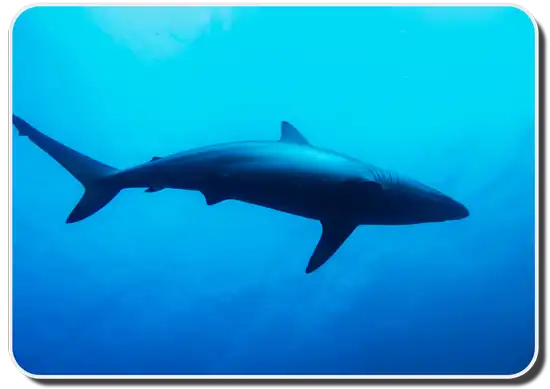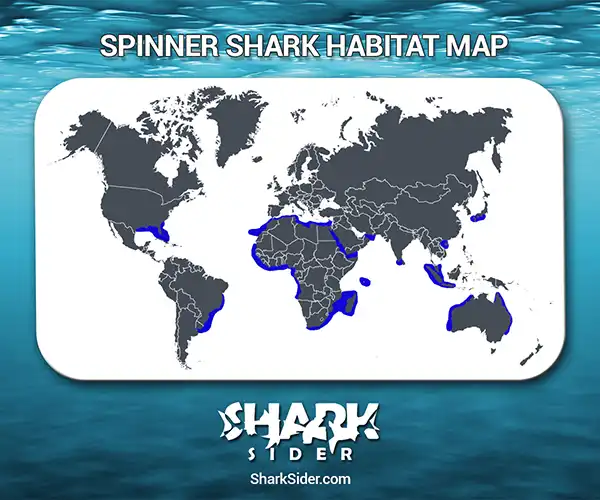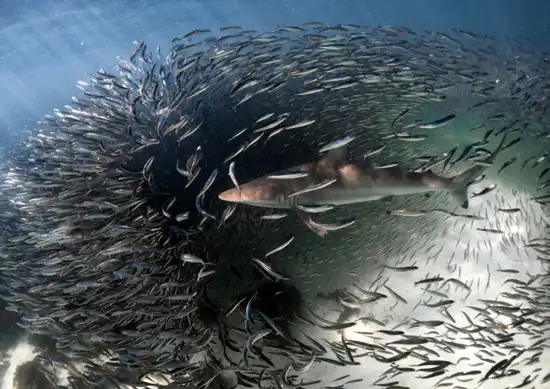Spinner sharks are requiem sharks named after the spinning motion they adopt and jump out of the water to catch their prey. They are recognizable from the distinct black tips on the anal fin, which helps distinguish them from the blacktip sharks with whom they are often confused because of a similarity in appearance.

Spinner Shark Scientific Classification |
|
| Kingdom | Animalia |
| Phylum | Chordata |
| Class | Chondrichthyes |
| Order | Carcharhiniformes |
| Family | Carcharhinidae |
| Genus | Carcharhinus |
| Scientific Name | C. brevipinna |
Description
These sharks are around 6.6-9.8 ft long and 123-200 lb. in weight. Their bodies are slim and streamlined, with long, pointed snouts, small, circular eyes, and five pairs of long gills. The upper rows of the jaw have 15–18 finely serrated teeth, while the lower jaw has 14–17 smooth teeth.
While the adult spinner shark has black tips on the dorsal and pelvic fins, like the blacktip shark, they even have a similar mark on their anal fin. The dorsal part of their body is gray or tinted copper with white bands, while the ventral region appears lighter. The younger sharks, however, lack markings on their fins.
Where do they live
Map Of The Spinner Shark’s Habitat

Depending on the location, the size of the species can vary, with those found in the Indo-Pacific being larger than the northwest Atlantic sharks. In the western Atlantic, they range from Cape Cod to south Brazil, while in the east, they have been spotted from Spain to Namibia, encompassing the Mediterranean Sea. In the Indo-West Pacific, they live in the Red Sea and around South Africa, Indonesia, Japan, and Australia.
They are adaptable and able to live in both the ocean’s depths and inshore coastal areas.
Behavior
Dietary
These sharks, swift and gregarious in getting at their prey, feed mainly on small bony fish, like anchovies, bluefish, bonito, croakers, herring, jacks, lizardfish, mojarras, mullets, sardines, sea catfish, tenpounders, tongue-soles, and tunas. They also eat stingrays, cuttlefish, squid, and octopus.
Predatory
The spinner shark will attack a school of fish in a group. They have a unique tactic where the shark will charge headfirst into the school while spinning and snapping its mouth. This effort provides enough momentum for the shark to jump out of the water.
Social
Spinner sharks sometimes form schools, separated by age and sex.
Migratory
The sharks living in the northwest Atlantic will migrate to southern deeper waters in the winter.
Reproductive
They are viviparous, giving birth to 3-20 pups after a gestation period of 11-15 months. Juveniles reach sexual maturity at 12-14 years and have a lifespan of 15-20 years.
 Adaptations
Adaptations
Their sharp teeth and streamlined bodies allow them to be effective predators.
Interactions with humans
While not necessarily dangerous to humans, these sharks can become highly excited in the presence of food and may start a feeding frenzy. They are a common sight around trawlers after they dump the bycatch after fishing.
The International Shark Attack File attributed 16 unprovoked and one provoked attacks to the spinner shark as of 2008, none fatal.
Spinner shark meat is quite popular, though sometimes it is labeled as “blacktip reef” shark because of the latter’s assumed superior quality.
As per the IUCN, the spinner shark is “Vulnerable” or “VU”. This is due to a loss of habitat, putting it at risk from human exploitation and degradation of coastal areas.
